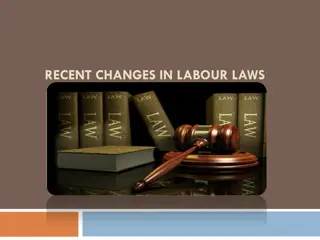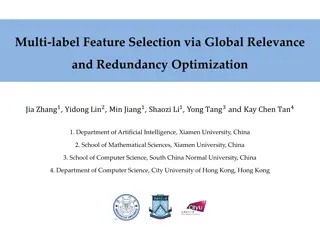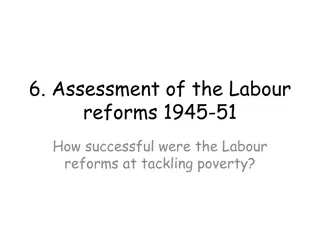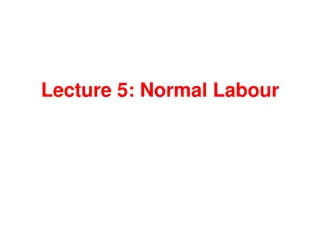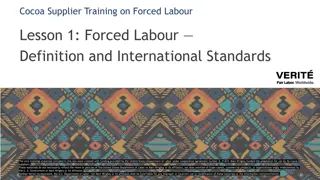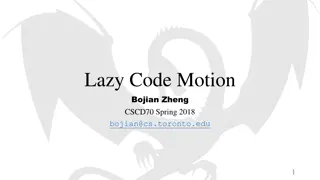
Understanding Collective Redundancy Directive 98/59 Framework
Explore the key aspects of Directive 98/59 on collective redundancies, including its background, aims, requirements, and impact. Learn about the protection it provides to workers, consultation processes, and the criteria for redundancies to be considered "collective."
Download Presentation

Please find below an Image/Link to download the presentation.
The content on the website is provided AS IS for your information and personal use only. It may not be sold, licensed, or shared on other websites without obtaining consent from the author. If you encounter any issues during the download, it is possible that the publisher has removed the file from their server.
You are allowed to download the files provided on this website for personal or commercial use, subject to the condition that they are used lawfully. All files are the property of their respective owners.
The content on the website is provided AS IS for your information and personal use only. It may not be sold, licensed, or shared on other websites without obtaining consent from the author.
E N D
Presentation Transcript
Collective redundancy Ainura, Gonzalo and Taeko
Overview - Directive 98/59 (Collective Redundancies) - National Legal Framework of the UK - C-80/14, C-182/13 and C-392/13 - Opinion of Advocate General - Impact of ECJ decision on the judgement - General conclusion
Directive 98/59 What are 'Collective Redundancies'? collective redundancies mean dismissals effected by an employer for one or more reasons not related to the individual workers concerned. 'Art.1.1.a)'
Background of the Directive 98/59/EC Directive 98/59/EC (1998) (Improved to increase communitarian legislation transparency) Directive 75/129/EEC (1975) (Approximation of the laws of the MS relating to collective redundancies) Directive 92/56/EEC (1992) The Directive entered into force in September 1998.
AIMS OF THE DIRECTIVE Improvement of the protection for the workers -Rules on the consultation of workers' representatives before redundancies are made - Provisions on practical support for the employees who are laid off Approximation of Member States' legislation concerning the practical arrangements and procedures for such redundancies
WHAT DOES THE DIRECTIVE DO? It requires employers to inform and consult staff representatives in the case of collective redundancies. It specifies the points which these consultations must cover and the information which the employer is required to provide. It also lays down the procedure for collective redundancies.
The requirements for the redundancies to be considered 'COLLECTIVE'... (i) either, over a period of 30 days: at least 10 in establishments normally employing more than 20 and less than 100 workers, at least 10% of the number of workers in establishments normally employing at least 100 but less than 300 workers, at least 30 in establishments normally employing 300 workers or more, (ii) or, over a period of 90 days, at least 20, whatever the number of workers normally employed in the establishments in question;
Directive 98/59, Article 5 This Directive shall not affect the right of Member States to apply or to introduce laws, regulations or administrative provisions which are more favourable to workers or to promote or to allow the application of collective agreements more favourable to workers.
KEY POINTS The directive does not apply to: collective redundancies effected under contracts of employment concluded for limited periods of time or for specific tasks, except where those redundancies take place prior to the date of expiry or the completion of such contracts; workers employed by public administrative bodies or by establishments governed by public law. In addition, the rights of employees when the ownership of a business changes or the business becomes insolvent are covered by other EU rules.
National Legal Framework United Kingdom Legislation 'TULRCA' Chapter II of Part IV of the Trade Union and Labour Relations (Consolidation) Act 1992 ( the TULRCA ) implements the United Kingdom s obligations under Directive 98/59 in respect of England and Wales, and Scotland. Section 188(1) of the TULRCA provides that: a) where an employer is proposing to dismiss as redundant 20 or more employees at one establishment within a period of 90 days or less, the employer is to consult about the dismissals all the persons who are appropriate representatives of any of the employees who may be affected by the proposed dismissals or may be affected by measures taken in connection with those dismissals. b) Where an employer fails to comply with a requirement of section 188 of the TULRCA, an employment tribunal may make a protective award under section 189(2), which, according to section 189(3), is an award ordering the employer to pay remuneration for the protected period as defined in section 189(4).
Case C-80/14 Union of Shop, Distributive and Allied Workers (USDAW) B. Wilson v WW Realisation 1 Ltd, in liquidation Ethel Austin Ltd Secretary of State for Business, Innovation and Skills Request for a preliminary ruling - Meaning of establishment Basic info: USDAW is a trade union with over 430 000 members across the United Kingdom. USDAW s members work in a variety of occupations and industries and include shop workers, factory and warehouse workers, drivers and call centre workers. Mrs Wilson was employed at the Woolworths store in St Ives, and was the USDAW representative on Woolworths national employee forum.
Facts The employers in this reference were two large retailers which had been trading in the UK, namely, Woolworths and Ethel Austin. They both (employers) had become insolvent and had entered into administration. Thousands of employees lost their jobs. However, the employees had lost their jobs without any consultation having been made beforehand, which was an arguably a requirement under the provisions of the TULRCA. Consequently, the workers put in claims for protective awards . The Secretary of State was joined as a party to the London Central Employment Tribunal proceedings against Woolworths on the basis that, in view of the employer s insolvency, the Secretary of State has a potential liability in respect of any protective awards made pursuant to national legislation implementing Directive 2008/94/EC (ensures payment of employees' outstanding claims in the event of employer insolvency)
On 2 November 2011 and 18 January 2012 respectively, the aforementioned tribunals made protective awards in favour of the former Woolworths and Ethel Austin employees, but approximately 4 500 workers were denied a protective award on the basis that they had worked at stores with fewer than 20 workers, each store being regarded as a separate establishment. On appeal, the Employment Appeal Tribunal ( the EAT ) held on 30 May 2013 that, in order to construe section 188(1) of the TULRCA in a manner compatible with Directive 98/59, it was necessary to delete the words at one establishment . The EAT also held that the dismissed workers could rely directly upon the directive and held the Secretary of State to However, the be responsible for the payment of protective awards to all the workers. Secretary of State insisted that the United Kingdom has not properly construed the concept at issue and accordingly failed to transpose that directive correctly into national law.
The court decided to stay the proceedings and to refer the following questions for a preliminary ruling: 1.(a) In Article l(l)(a)(ii) of [Directive 98/59] does the phrase at least 20 refer to the number of dismissals across all of the employer s establishments in which dismissals are effected within a 90 day period, or does it refer to the number of dismissals in each individual establishment? (b) If Article l(l)(a)(ii) refers to the number of dismissals in each individual establishment, what is the meaning of establishment ? In particular, should establishment be construed to mean the whole of the relevant retail business, being a single economic business unit, or such part of that business as is contemplating making redundancies, rather than a unit to which a worker is assigned their duties, such as each individual store.
Case 182/13 REQUEST for a preliminary ruling under Article 267 TFEU from the Industrial Tribunal (Northern Ireland), Belfast (United Kingdom), made by decision of 26 March 2013, received at the Court on 12 April 2013, in the proceedings Valerie Lyttle, Sarah Louise Halliday, Clara Lyttle, Tanya McGerty V. Bluebird UK Bidco 2 Limited
Facts 1. This request for a preliminary ruling concerns the interpretation of Article 1(1)(a)(ii) of Council Directive 98/59/EC of 20 July 1998 on the approximation of the laws of the Member States relating to collective redundancies (OJ 1998 L 225, p. 16). 2. The claimants in the main proceedings brought an action contesting the validity of their dismissals before the referring tribunal. 3. The claimants in the main proceedings were dismissed, together with other employees, on 12 March 2012. The dismissal process was not preceded by any consultation procedure as referred to in Directive 98/59.
Case 182/13 Bluebird UK Bidco 2 Ltd ( Bluebird ) is the current owner of the Bonmarch business. In January 2012, Bonmarch had 394 clothing stores throughout the United Kingdom and the Isle of Man, where around 4 000 workers were employed. In Northern Ireland and the Isle of Man (which were considered to constitute a single administrative unit), Bonmarch at the time operated 20 stores with 180 workers. As the previous owner of Bonmarch had become insolvent and gone into administration, that business was transferred to Bluebird on 20 January 2012. In the spring of 2012, Bluebird carried out a redundancy programme throughout the United Kingdom and the Isle of Man. As a result, there are now only 265 Bonmarch stores and approximately 2 900 employees in the United Kingdom, with 8 stores and 75 employees remaining in Northern Ireland. The redundancy process which culminated in the dismissals did not begin before January 2012 and did not include any collective consultation which would have satisfied the requirements of Directive 98/59. All the relevant redundancies took effect on 12 March 2012. The four claimants in Case C-182/13 form part of a group of 19 employees of the Northern Ireland Bonmarch who were made redundant during the spring of 2012 and who have brought cases before the Northern Ireland Industrial Tribunals. The four claimants worked at four different Bonmarch stores at various locations across Northern Ireland with fewer than 20 employees at each store.
Entertaining doubts as to the proper interpretation of Directive 98/59, the Industrial Tribunals decided to stay the proceedings and to refer the following questions for a preliminary ruling: In the context of Article 1(1)(a)(ii) of [Directive 98/59], does establishment have the same meaning as it has (1) in the context of Article 1(1)(a)(i)? If not, can an establishment , for the purposes of Article 1(1)(a)(ii), be constituted by an organisational sub- (2) unit of an undertaking which consists of or includes more than one local employment unit? In Article 1(1)(a)(ii) of the directive, does the phrase at least 20 refer to the number of dismissals across all (3) of the employer s establishments, or does it instead refer to the number of dismissals per establishment? (In other words, is the reference to 20 a reference to 20 in any particular establishment, or to 20 overall?)
Directive 98/59 Article 1 Article 1 of the directive, entitled Definitions and scope , provides: 1. For the purposes of this Directive: (a) collective redundancies means dismissals effected by an employer for one or more reasons not related to the individual workers concerned where, according to the choice of the Member States, the number of redundancies is: (i) either, over a period of 30 days: at least 10 in establishments normally employing more than 20 and less than 100 workers, at least 10% of the number of workers in establishments normally employing at least 100 but less than 300 workers, at least 30 in establishments normally employing 300 workers or more, (ii) or, over a period of 90 days, at least 20, whatever the number of workers normally employed in the establishments in question;
2. This Directive shall not apply to: collective redundancies effected under contracts of employment concluded for limited periods of time or for specific tasks except where such redundancies take place prior to the date of expiry or the completion of such contracts; (a)
Directive 98/59 Article 2 1. Where an employer is contemplating collective redundancies, he shall begin consultations with the workers representatives in good time with a view to reaching an agreement. 2. These consultations shall, at least, cover ways and means of avoiding collective redundancies or reducing the number of workers affected, and of mitigating the consequences by recourse to accompanying social measures aimed, inter alia, at aid for redeploying or retraining workers made redundant.
3. To enable workers representatives to make constructive proposals, the employers shall in good time during the course of the consultations: (a) supply them with all relevant information and (b) in any event notify them in writing of: (i) the reasons for the projected redundancies; (ii) the number and categories of workers to be made redundant; (iii) the number and categories of workers normally employed; (iv) the period over which the projected redundancies are to be effected; (v) the criteria proposed for the selection of the workers to be made redundant in so far as national legislation and/or practice confers the power therefor upon the employer; (vi) the method for calculating any redundancy payments other than those arising out of national legislation and/or practice. The employer shall forward to the competent public authority a copy of, at least, the elements of the written communication which are provided for in the first subparagraph, point (b), subpoints (i) to (v).
United Kingdom law Directive 98/59 was transposed into the legal system of Northern Ireland by Part XIII of the Employment Rights (Northern Ireland) Order 1996 and by Part IV, Chapter II of the Trade Union and Labour Relations (Consolidation) Act 1992 so far as concerns England and Wales and Scotland. Article 216 of the Employment Rights (Northern Ireland) Order 1996 provides that where an employer is proposing to dismiss as redundant 20 or more employees at one establishment within a period of 90 days or less, the employer shall consult about the dismissals all the persons who are appropriate representatives of any of the employees who may be affected by the proposed dismissals or may be affected by measures taken in connection with those dismissals.
Meaning of the term establishment Accordingly, such a store is capable of satisfying the criteria set out in the case-law cited in paragraphs 28, 30 and 32 relating to the term establishment in Article 1(1)(a) of Directive 98/59; this is, however, a matter for the referring tribunal to establish in the light of the specific circumstances of the dispute in the main proceedings. 28. In paragraph 31 of the judgment in Rockfon (C-449/93, EU:C:1995:420), the Court observed, referring to paragraph 15 of the judgment in Botzen and Others(186/83, EU:C:1985:58), that an employment relationship is essentially characterised by the link existing between the worker and the part of the undertaking or business to which he is assigned to carry out his duties. The Court therefore decided, in paragraph 32 of the judgment in Rockfon (C-449/93, EU:C:1995:420), that the term establishment in Article 1(1)(a) of Directive 98/59 must be interpreted as designating, depending on the circumstances, the unit to which the workers made redundant are assigned to carry out their duties. It is not essential in order for there to be an establishment that the unit in question is endowed with a management that can independently effect collective redundancies.
Meaning of the term establishment 30. In the judgment in Athina ki Chartopoi a (C-270/05, EU:C:2007:101), the Court further clarified the term establishment , inter alia by holding, in paragraph 27 of that judgment, that, for the purposes of the application of Directive 98/59, an establishment , in the context of an undertaking, may consist of a distinct entity, having a certain degree of permanence and stability, which is assigned to perform one or more given tasks and which has a workforce, technical means and a certain organisational structure allowing for the accomplishment of those tasks. 32. In paragraph 28 of the judgment in Athina ki Chartopoi a (C-270/05, EU:C:2007:101), the Court held that since Directive 98/59 concerns the socio-economic effects that collective redundancies may have in a given local context and social environment, the entity in question need not have any legal autonomy, nor need it have economic, financial, administrative or technological autonomy, in order to be regarded as an establishment .
ECJ Decision on cases 80/14, 182/13 -The Court held that the term establishment in Article 1(1)(a)(ii) of Directive 98/59 must be interpreted in the same way as the term in Article 1(1)(a)(i) of the Directive.According to the case-law of the Court, where an undertaking comprises several entities meeting the criteria set out in this case-law, it is the entity to which the workers made redundant are assigned to carry out their duties that constitutes the establishment for the purposes of Article 1(1)(a) of Directive 98/59. The definition in Article 1(1)(a)(i) and (a)(ii) of Directive 98/59 requires that account be taken of the dismissals effected in each establishment considered separately. -The Court held that the Directive does not preclude national legislation that lays down an obligation to inform and consult workers in the event of the dismissal, within a period of 90 days, of at least 20 workers from a particular establishment of an undertaking, and not where the aggregate number of dismissals across all of the establishments or across some of the establishments of an undertaking over the same period reaches or exceeds the threshold of 20 workers. (C-182/13 and 80/14) -It should also be made clear that it is for the referring courts in all three cases to determine how exactly the local employment unit is constituted in each situation, that being a factual matter. To take an example, if an employer operates several stores in one shopping centre, it is not inconceivable that all those stores should be regarded as forming a single local employment unit.
ECJ Decision on cases 80/14, 182/13 - The court noted that interpreting the Directive to require account to be taken of the total number of redundancies across all of the establishments of an undertaking would significantly increase the number of workers eligible for protection, which would correspond to one of the objectives of the Directive. However, this was not the only objective of the Directive; it is also to ensure comparable protection for workers rights in the different Member States, and to harmonise the costs which such protective rules entail for EU undertakings. The interpretation of the Directive argued for by the union would be contrary to those objectives.
FACTS- CASE (C-392/13) From 14 January 2008, Mr Rabal Ca as worked for Nexea - Nexea had two establishments in Madrid and in Barcelona (Spain). - On 20 July 2012, that undertaking dismissed 14 employees at the establishment in Madrid, on the basis of a reduction in turnover for three consecutive quarters, losses sustained in 2011 and those forecast for 2012. The legal actions contesting those dismissals were dismissed. - Mr Rabal Ca as contested his dismissal before the referring court, claiming that it was void on the ground that Nexea had fraudulently circumvented the application of the procedure relating to collective redundancies, which is mandatory under Directive 98/59. - The applicant submits, first, that Nexea ought to have had recourse to that procedure, since the closure of the establishment in Barcelona, which had resulted in 16 terminations of employment relationships in December 2012, could be regarded as constituting a collective redundancy since that closure and the dismissal of the entire workforce were to be assimilated to the closure of the undertaking or the cessation of its business activity.
FACTS- CASE (C-392/13) -The referring court said that the five terminations of employment contracts that took place in October and November 2012, might be added to the 13 dismissals effected in December 2012, amongst which is that of Mr Rabal Ca as. If so, the total number of employment contract terminations would be 18 over a period of 90 days, which number represents more than 10% of the personnel, and, therefore, those dismissals would be considered to be collective redundancies . -This court seeks clarification of the concept of establishment in Article 1(1)(a) of Directive 98/59 -The court adds that, collective redundancy also arises where the contracts of employment of an undertaking s entire workforce are terminated as a result of the total cessation of the undertaking s business activity, provided that the number of workers affected is greater than five. On the other hand, according to that court, that national legislation reserves different treatment for dismissals consequent on the closure of an establishment of an undertaking. - In those circumstances the Juzgado de lo Social No 33 de Barcelona (Social Court No 33 of Barcelona) decided to stay the proceedings and to refer the following questions to the Court of Justice for a preliminary ruling.
Spanish legislation -CASE (C-392/13) Directive 98/59 is transposed into Spanish law by the Ley del Estatuto de los Trabajadores (7) ( Law on the Workers Statute ; the ET ). Article 51(1) of the ET ( Collective dismissals ) provides: For the purposes of the present Law, collective redundancy shall mean the termination of employment contracts on economic, technical, organisational or production grounds where, over a period of 90 days, the termination affects at least: (a) 10 workers in undertakings employing fewer than 100 workers. (b) 10% of the number of workers in undertakings employing between 100 and 300 workers. (c) 30 workers in undertakings employing more than 300 workers. The economic grounds shall be deemed to have been established where a negative economic situation is apparent from the financial performance of the undertaking, such as where losses are actually sustained or forecast or where there is a persistent reduction in ordinary revenue or sales. In any event, a reduction shall be deemed to be persistent if, for three consecutive quarters, the level of ordinary revenue or sales in each quarter is lower than that recorded in the same quarter of the preceding year In order to calculate the number of terminations of contracts for the purposes of the first subparagraph of this paragraph, account shall also be taken of any other terminations which have occurred within the reference period on the employer s initiative, for other reasons, unrelated to the individual workers concerned and different from the grounds provided for in Article 49(1)(c) of this Law,[(8)]provided that the number of terminations is at least five
Questions raised by National Court-CASE (C-392/13) The referring court asks, in essence, whether Article 1(1) of Directive 98/59 must be interpreted as meaning that, for the purposes redundancies , within the meaning of that provision, have been effected, account has also to be taken of individual terminations of contracts of employment concluded for limited periods of time or for specific tasks, when those terminations take place on the date of expiry of the contract of employment or on the date on which that task was completed. of establishing whether collective -Article 1(1) of Directive 98/59 must be interpreted as meaning that, for the purposes of establishing whether collective redundancies , within the meaning of that provision, have been effected, there is no need to take into account individual terminations of contracts of employment concluded for limited periods of time or for specific tasks, when those terminations take place on the date of expiry of the contract or on the date on which that task was completed.
Whether Article 1(2)(a) of Directive 98/59 must be interpreted as meaning that, for the purposes of establishing the existence of collective redundancies effected under contracts of employment concluded for limited periods of time or for specific tasks, it is necessary for the cause of such collective redundancies to derive from the same collective contractual framework for the same duration or the same task. -It is not necessary for the cause of such collective redundancies to derive from the same collective contractual framework for the same duration or the same task. Given that it includes within its ambit all dismissals effected by an employer for one or more reasons not related to the individual workers concerned , according to the numerical threshold provided for, must the concept of collective redundancies in Article 1(1)(a) of Directive 98/59 be interpreted in view of its Community scope as prohibiting or precluding a national implementing or transposing provision that restricts the ambit of that concept solely to particular types of termination, namely those based on economic, technical, organisational or production grounds, as Article 51(1) of the [ET] does? -Article 1(1)(a) of Directive 98/59 must be interpreted as precluding national legislation that introduces the undertaking and not the establishment as the sole reference unit, where the effect of the application of that criterion is to preclude the information and consultation procedure, when the dismissals in question would have been considered collective redundancies , under the definition in Article 1(1)(a) of that directive, had the establishment been used as the reference unit.
AG Opinion on the cases C-80/14, C-182/13, C-392/13 The three cases under consideration essentially raise the same question and, accordingly, he deals with them all together in this Opinion, despite the fact that they have not formally been joined. The question that arises in each of these cases is: what is the exact scope, for the purposes of determining whether collective redundancies have taken place, of the concept of establishment referred to in Article 1(1)(a) (2) of Directive 98/59/EC? In the light of the foregoing, he proposes that the Court respond as follows to the questions referred in Case C-182/13 by the Industrial Tribunals (Northern Ireland) (United Kingdom), to Question 4 in Case C-392/13, referred by the Juzgado de lo Social No 33 de Barcelona (Spain), and to the questions referred in Case C-80/14 by the Court of Appeal (England and Wales) (United Kingdom):
AG Opinion on the cases C-80/14, C-182/13, C-392/13 - The concept of establishment as referred to in Article 1(1)(a)(ii) of Council Directive 98/59/EC of 20 July 1998 on the approximation of the laws of the Member States relating to collective dismissals has the same meaning as under Article 1(1)(a)(i) of that directive. That concept denotes the unit to which the workers made redundant are assigned to carry out their duties, which it is for the national court to determine. That does not preclude Member States from enacting implementing rules on the basis of that concept which, without lowering the level of minimum protection, are more favourable to workers. The national court is to verify that this is the case.
AG Opinion on the cases C-80/14, C-182/13, C-392/13 - He considered that the Court in Athina ki Chartopoi a and Rockfon had rejected an interpretation of establishment which equated the meaning of that term with the entire undertaking in question or the corporate legal entity. He rejects then the key thrust of the USDAW argument, para 47: Indeed, the approach argued for by the applicants in Cases C-182/13 and C-80/14 is to extend the protective procedure to all workers dismissed in the course of the same restructuring exercise, irrespective of the size of the establishment at which they worked. Conferring the maximum level of protection by downplaying the method of implementation would obviously be to the advantage of those workers who, under the current understanding of the concept at issue, are not entitled to any protective award. However, such an approach would not be consonant with the minimum harmonisation aim envisaged by Directive 98/59, which, as the Commission rightly stated at the hearing, does not contemplate as a starting point full protection for all even where the number of dismissals exceeds the thresholds as the temporal requirement must also be met.
AG Opinion on the cases C-80/14, C-182/13, C-392/13 - It is further of note that the AG focuses upon the argument that the definition was intended to address the impact of redundancies in a given local context and social environment . In this context it is the local employment unit which is important and he was not persuaded that the social protection aim argued by USDAW required a different approach to be taken. - Whilst his conclusion is that the key issue is the local unit to which employees are assigned he does note that what these means is a matter for domestic Courts to determine in any given situation: Lastly, it should also be made clear that it is for the referring courts in all three cases to determine how exactly the local employment unit is constituted in each situation, that being a factual matter. To take an example, if an employer operates several stores in one shopping centre, it is not inconceivable that all those stores should be regarded as forming a single local employment unit. As observed by the Spanish Government, that will depend on a number of factors: (i) whether the joint entity in question can be said to have a certain degree of permanence and stability; (ii) whether it is assigned to perform one or more given tasks; and (iii) whether its workforce, technical means and organisational structure are adequate for the accomplishment of those tasks. It is not necessary for the entity to have legal, economic, financial, administrative or technological autonomy in order to be regarded as an establishment.
AG Opinion on the cases C-80/14, C-182/13, C-392/13 In Case C-392/13, he proposes the Court respond as follows to Questions 1, 2 and 3: Article 1(1) of Directive 98/59 precludes a provision of national law, such as Article 51(1) of the Ley del Estatuto de los Trabajadores of 29 March 1995, under which there must be at least five terminations of employment contracts without the consent of the workers concerned, on grounds other than economic, technical, organisational or production grounds, before such terminations may be taken into account for the purposes of determining whether collective redundancies have taken place. On a proper construction of Article 1(2)(a) of Directive 98/59, all collective redundancies effected under contracts of employment concluded for limited periods of time or for specific tasks are excluded from the scope of that directive, save where such redundancies take place prior to the date of expiry of such contracts or before their completion. It is irrelevant whether the grounds for the termination of such contracts are the same. That does not preclude Member States from enacting rules which, without lowering the level of minimum protection, are more favourable to workers.
AG Opinion The concept of establishment as referred to in Article 1(1)(a)(ii) of Council Directive 98/59/EC of 20 July 1998 on the approximation of the laws of the Member States relating to collective dismissals has the same meaning as under Article 1(1)(a)(i) of that directive. That concept denotes the unit to which the workers made redundant are assigned to carry out their duties, which it is for the national court to determine. That does not preclude Member States from enacting implementing rules on the basis of that concept which, without lowering the level of minimum protection, are more favourable to workers. The national court is to verify that this is the case. On a proper construction of Article 1(2)(a) of Directive 98/59, all collective redundancies effected under contracts of employment concluded for limited periods of time or for specific tasks are excluded from the scope of that directive, save where such redundancies take place prior to the date of expiry of such contracts or before their completion. It is irrelevant whether the grounds for the termination of such contracts are the same. That does not preclude Member States from enacting rules which, without lowering the level of minimum protection, are more favourable to workers.
Impact of ECJ Decision in our cases -Did the ECJ apply the same or different reasoning to the Advocate General? The overall rationale of the ECJ's judgment is broadly the same as that adopted by the Advocate General. Does the ECJ's judgment effectively determine the issues in the case (which will now return to the Court of Appeal) or is there still scope for argument as to how the ECJ's conclusions will apply on the facts? Unlike many judgments of the ECJ (particularly in the field of holiday pay and the Working Time Directive 2003/88/EC), the decision is clear, concise and not open to any arguments on interpretation. The Court of Appeal will have no choice but to overturn the decision of the EAT and restore the first-instance tribunal decisions that the relevant group of redundant employees (those working in stores with under 20 employees) are not entitled to bring protective award proceedings.
Personal Opinion about C-80/14 The challenge to the existing legislation was both innovative and tenacious. I agree with USDAW's view that all of its members, who were made redundant following the insolvency of an entire company, should have an equal right to claim for protective awards.
Personal Opinion about case 182/13 So, collective redundancies at separate establishments could cause collective consultation requirements which could lead to employers having to collectively consult even though the reasons for the redundancies were different. Large employers would have to constantly monitor their procedure for any dismissal which might be categorised as a redundancy because of the risk that this could trigger collective consultation obligations. This places a huge administrative burden on employers. In my opinion, all the employers should be responsible for every dismissal and provide a good consultation in a good time with workers or their representatives. These consultations shall, at least, cover ways and means of avoiding collective redundancies or reducing the number of workers affected, and of mitigating the consequences by recourse to accompanying social measures aimed, inter alia, at aid for redeploying or retraining workers made redundant.
Personal opinion-CASE (C-392/13) I have the same employer s opinion because in that kind of case the employees are helpless about the situations could have the company. That situation affect but sometimes is not employee s cause, so he shoud be more respected when it happens according with their laws. About this, is important to say that under recital 2 of Directive 98/59, it is important that greater protection should be afforded to workers in the event of collective redundancies while taking into account the need for balanced economic and social development within the European Union.
GENERAL CONCLUSION The main difference between the Community law and the national law is the field of extensional or organizational reference in relation to the calculation of contractual extinctions. Generally, calculation for a company rather than workplace is more restrictive because it has no effects of dispersion of cessation among several workplaces. The National rule is considered more favorable for workers and therefore not incurred in violation of the directive.
The terms undertaking and establishment are different and that an establishment normally constitutes a part of an undertaking. That does not, however, prevent the establishment being the same as the undertaking where the undertaking does not have several distinct units. It is clear from the wording and scheme of Directive 98/59 that individual terminations of contracts concluded for limited periods of time or for specific tasks are excluded from the scope of that directive. Consequently, for the purposes of establishing whether collective redundancies , within the meaning of the directive, have been effected, there is no need to take into account individual terminations of such contracts.
Three recent cases decided by the ECJ could have a significant impact on the procedures that are adopted by any employers considering carrying out collective redundancies. The duty is to inform and consult appropriate representatives of the affected employees. Where the duty applies, the employer must also notify competent public authority of the proposed redundancies. Affected employees are those affected by the proposed dismissals or by measures proposed to be taken in connection with the dismissals. These consultations shall, at least, cover ways and means of avoiding collective redundancies or reducing the number of workers affected, and of mitigating the consequences by recourse to accompanying social measures aimed, inter alia, at aid for redeploying or retraining workers made redundant. All the cases above significantly impact on the scope of an employer s collective consultation obligations, and as employment law , have given a significant degree of thought to the implications of these decisions on employers, and the practical impact it might have on their business.





